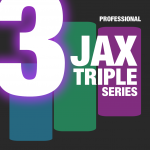
JAX 3Stereo (3.6) was released on the Apple appStore today. An update (version 3.7 was appended too). 3Stereo is the successor and (replacement?) of our popular JAX StereoTool and adds triple band processing.

JAX 3Stereo is the evolution of our legacy JAX StereoTool, one of the very first iOS releases we ever made. It extends the essential functions for stereo analysis and processing for usage on an analog style triple band-split. The old all-pass mode is still available and so it aims to replace this existing legacy release.
JAX 3Stereo is super universal, thus being available on iOS, iPadOS, visionOS and macOS now.
Existing customers of the purchased version of the JAX StereoTool 1/2 are entitled for a free upgrade via promotion code. Please contact us via email.
( JAX StereoTool was originally free, customers of the purchased versions can provide the AppStore receipt for getting a free promo code for JAX 3Stereo. )


StereoTool vs. 3Stereo Tests.
With respect, I would plead with you to retain StereoTool, as I noticed whilst testing same, it has a hidden gem called “air separation” between instruments. I can assure you this is a rarity in digital recording, or what the late Bob Ross use to say, “A Happy Accident”.
For example, having been involved in sound engineering for fifty-five years, one of the major problems with digital, is that it struggles with creating air between instruments, which is not a problem with analogue.
So in my opinion, StereoTool is a life saver that will allow instrumentation to breathe, and give your music productions real class going forward. So I would strongly recommend to not only keep StereoTools in circulation, but retitle it as “StereoTools Air”, so as to distinguish it from 3Stereo, which has a different type of sound presentation, which I was also testing.
FINAL ANALYSIS:
In a nutshell, the character of the JAX StereoTool plugin has what we call the broadband “Smile Equaliser Graph”, also known as the British Eq, and is the reason why we are hearing air separation between music instruments, which I cannot empathise enough, is so vital in music productions today, that StereoTool must be preserved.
On the other hand, the JAX 3Stereo seems to use the American broadband Eq, that not only pushes the mid-range forward, but also creates a much louder sound takeaway, but doesn’t appear to offer the same sonic separation as the StereoTool. Nevertheless, if you want a more punchy sound, then 3Stereo will get you there.
So as you can see, there is a difference between the two plugins, and why it’s important to keep both plugins in circulation. This strategy is often referred to as back-end selling, where the StereoTool feeds off the 3Stereo, and visa versa, simply because sound engineers like to have two of everything… just saying 😉
This is a nice idea. Keeping the old tool.
Technically spoken (from a developer’s perspective) the 3Stereo should give the absolute same result if used in ‘Allpass’ mode. So I am somewhat confused now.
Possibly this is really a kind of ‘happy accident’. I have to make a bytewise comparsion of the code next.
The other thing is, the old StereoTool was compiled with an quite ancient Apple compiler. This also could have an effect, regarding the floating point processing or rounding or such. Because in the meantime I develop everything on the Apple Silicon machines. The old Intel Mac has gone for development, as it runs hot like hell and compiles forever…
There is the danger, that a re-compile of the old tool with a new name (and compiler generation) will destroy all this ‘happy accident’,
And then unfortunately there is no way back…
The only chance would be to let the StereoTool untuched until the time point, when Apple is removing it per auto bot, because not updated. This happened several times to my releases! Unfortunately. ^^
By the way:
The JAX StereoTool and 3Stereo have some really unique features, i.e. the mono recovery and the inbuilt delay based phase adjustor (haas), which is rarely recognized/adopted by the common iOS community. If I look at the sales numbers, I could start hefty crying. It is anyhow like ‘trashing pearls in front of the pigs’. So in that regard, Apple’s remove bot algorithm probably will give it the kiss of death next, because the sales numbers are so low. These were merely high, when it was free, b.t.w … ^^
Niall,
could you please test JAX Dynamics Flow? 🙏 It is not released yet but Public Beta.
Because this Tool is specifically designed for the ‘air’ thingy. Especially the hi-band in connection with the De/Saturator parameter. ^^ It has different stereo modi and mid/side too, although it is a multi compander <-> analog wide band filter based dynamics processor.
This project gave me that ‘happy accident’ feel, because I was quite surprised how good it works on just any sound, something quite magical. The project initially was merely a prototype to test and develop the core compander model. But is actually turned out so surprisingly good, that I will release it next. It is 3 or 4 years old and was quite frozen in development state after creation, by the way. ^^
Hint:
I would also recommend to keep track with the new JAX Selective Range Series in general. There is some magic goin on there too. And loads of processors are planned for this concept. And for the competitors (half of my youtube subscribers are just enemies and competitors!) : Simply copying the concept won’t work. ^^
Hi Admin,
Will have to get back to you on the JAX Dynamics Flow later, as I am prepping my house for visiting heating engineers due next week. Have also further interesting discoveries regarding StereoTool, where you might want to call in the Ghost-hunters 😄😄😄
Niall
Re JAX Dynamic Flow, and StereoTool Update:
I didn’t hear any air separation with JAX Dynamic Flow. As regards StereoTool, I still have difficulty as to how it’s able to create this “air phenomena” with instruments on adjacent tracks, that are not directly connected to the plugin.
For example, when I placed the StereoTool on an Orchestral String loop on Track 2, it immediately began to change the sound of a Grand Piano on Track 1, and yet this virtual Grand Piano was on a separate track entirely, and had no connection whatsoever to Track 2. Technically speaking, this should not happen.
Even more crazy, when Track 2 was muted, the StereoTool continued to influence the above Grand Piano on Track 1. It’s only when you actually turn off the StereoTool plugin device itself, that the “air phenomena” cease’s. In addition, the JAX iMake Louder plugin, is also producing the same “air phenomena” as StereoTool.
So there are two ways of looking at this, first, can you tell me, have you noticed any sonic change between the old Apple Compiler you mentioned before, and the current compiler you are working with now? If so, this might be the reason we are hearing this “air phenomena”. Nevertheless, it does not explain why StereoTool and iMake Louder have the same capability of changing the sound of instruments on unconnected audio tracks as well?
The second way of looking at it… is a long shot. But it’s possible we are dealing with Morphic Fields, and that you may have a gift for this extraordinary technology, without realizing it. Based on research, morphic fields have been around for thousands of years, where some experts believe, that folks from the distant past, may have been using it unintentionally, without being aware of it.
So the big question is, when you first created StereoTool, did you by any chance come into contact with anyone who may have been experimenting with Morphic Fields, as this might explain why the above mentioned plugins are acting so strange?
Incidentally, if StereoTool or iMake Louder has been protected by Morphic Fields, then this “air phenomena” will only work for people who actually buy your original plugin. It should not work if the original plugin code is copied by another competitor, as the Morphic Field in question, has not been sanctioned to function, if transferred or copied by a third party. So you might say, all this is the ultimate copyright protection tool, when it comes to audio technology.
Cheers.
Niall
Sorry, but I cannot follow here.
An audio unit is a black box, that gets all commands and buffers from the host app. so if it processes at a wrong channel of audio data, as you say, so this is definitely a host issue. An audio unit would not be able to cross the boundaries here…
The thingy with the copyright tool or morphic fields, I do not even understand what about you are talking here. We do not use any copyright protections with any of our releases and also will not. This also would not pass the AppStore and being rejected.
The only reason i can imagine here is, that there is accidentally a delay on one stereo channel, that StereoTool processes, maybe an uninitialized value or such, which in return adds a phase offset to the right stereo channel. But only on the audio buffers, that are actually delivered by the host. It is like the so-called ‚Haas Effect‘ and thought for active stereo phase correction, i.e. a misplaced microphone with constant wrong phase offset. Stereo phase issues on a single mix channel can affect and change the sound of an entire mix drastically.
Otherwise there is a ghost in our audio units. (Kind of woodoo A.I.) ^^ But with his own will. Untameable!
Most people do not very well understand the fundamentals of stereo processing. Even if it is basically just super simple math. But. In fact this is the most important and most complex part of audio engineering at all. A wrong adjustment, an accidentally made and undiscovered phase inversion for instance or any failure inside the stereo chain drastically can affect the final results and the entire mix. This is especially true when using loads of dynamics processors, EQs, saturators and filters and so on. Some samples of wrong phase can make everything worse but also improve on the other side.
The only tools that really work here, are the human ears in connection with the brain. I personally think, that most reverbs for instance do introduce stereo issues which can be corrected only by separating the effect on send channels and doing further adjustments to the phase.
Another thing I discovered regarding that lately was, that Logic Pro X for instance does very strange things with mixing and the internal delay compensation. Adding just a new bus will change suddenly the internal sample buffer relations and introduce giant phase issues. The insert bus can have a complete different buffer size than the send buffer, which is not compensated correctly then. Inserting or removing a single effect processor can change everything in relation to the final audio phases in the mix, which is then resulting in damaged audio phases. This happens all the time and even can happen, if you reload a saved project, where everything was adjusted perfectly. I did discover this, when trying to synchronize a remote effect, which just was impossible to achieve without issues.
p.s. I am currently sporadically experimenting with controlled stereo phase offsets in a new selective range series effect, the JAX Selective Range : Airforce.
But all my time now is going into the JAX SH-116 OMNI release, a multi timbre synthesizer. It is also, because the sales on audio effects are exorbitantly low.